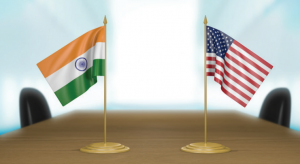
In 2016, the US recognised India as a “Major Defence Partner”, a designation that allows India to buy more advanced and sensitive technologies from America at par with that of the US’ closest allies and partners
As per the “Defence Framework Agreement”, India would receive licence-free access to a wide range of dual-use technologies in conjunction with steps that India has committed to take to advance its export control objectives
In 2018, India was placed in the United States’ Strategic Trade Authorisation-1 (STA-1)1 which will
ease export controls for high technology product sales to the country Of the four fundamental defence agreements between US & India, the third one, a military information sharing pact, was signed at the 2+2 bilateral summit held between the two countries.
The Communications Compatibility and Security Agreement (Comcasa), will give India access to advanced new defence systems like armed drones and will enable the armed forces to exploit existing US-origin platforms much more efficiently. The pact will pave the way for fitting special communications systems on Indian platforms like the C130J and the Naval P8I aircraft that will enable them to interact with the US military.
| Existing | Prospective |
|---|---|
| India purchased six Lockheed Martin C-130J Super Hercules aircrafts from the US in 2017 at an approximate cost of USD 835 million. Tata Advanced Systems Ltd. (TASL) has been selected as it’s Offset partner. | Tata Motors has tied up with Bharat Forge and US-based General Dynamics land Systems (GDlS) for India’s INR 50,000-crore future infantry combat vehicle (FICV) project. |
| India agreed to purchase 145 M777 Howitzer guns from BAE systems in 2018 at an approximate cost of USD 700 million. Mahindra Defence Systems Ltd. has been selected as its Offset partner. | Lockheed Martin has announced it is to build all wings for the F-16 fighter jet in India. The company is expected to partner with Indian firm TASL to manufacture the wings at a facility in Hyderabad from late 2020. |
| Tonbo Imaging, a start-up based in Bengaluru, bagged a USD 100 million contract to manufacture and export ‘night-vision sights’ for guns to be sold by US manufacturer United Weapon Systems Inc to the Peruvian army. | |
| Raytheon has bagged a USD 23.2 million contract from Tata Power’s Strategic Engineering Division (SED) in a programme to automate air traffic management systems of the Indian Air Force. The contract was part of the Indian Armed Forces’ project for modernization of its airfield infrastructure (MAFI). | The US state department has approved the direct sale of powerful stinger missiles to India, along with six AH-64E Apache attack helicopters and Hellfire missiles. Raytheon has entered an agreement with home-grown TASL to manufacture the missile’s components in India |
| Honeywell Aerospace has signed a licensing agreement with Tata Power’s SED enabling it to produce Honeywell’s Tactical Advanced Land Inertial Navigator, or “TALIN” in India. Honeywell shall license the design and hardware to assemble, test and eventually build the production kits for the navigation system in India. |
The Defence Technology and Trade Initiative (DTTI) was set up between the two countries in 2012 and has proposed 4
projects, namely:
– Mobile electronic hybrid power sources,
– Roll on/ Roll off kits for C-130 aircrafts,
– Next generation protective ensemble, and
– Next generation mini unmanned aerial vehicles
___________________________________________________________________________________________________________
1 STA is the licence exemption that allows a set of items on the Commerce Control List to be exported from the US under defined conditions without a transaction-specific licence. STA Tier 1 treatment, comparable with NATO allies, will expand the scope of exports that can be made to India without individual licences. This regulatory change will enhance the bilateral defence trade relationship and result in a greater volume of US exports to India. This will help India getting critical and latest technology from the US in the defence as well as certain other key areas.
